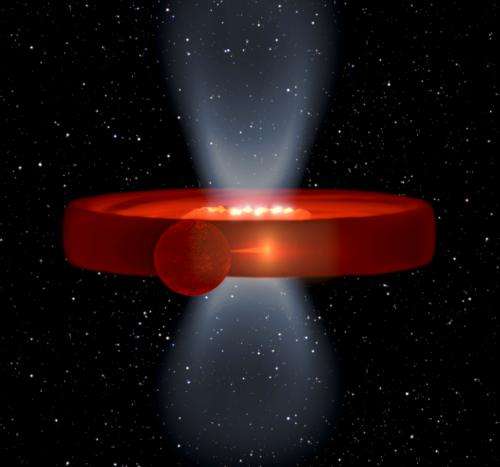March 1, 2013 report
Researchers find 'structure' in black hole accretion disk

(Phys.org)—A team of researchers working at the Astrophysical Institute of the Canary Islands has found evidence of a previously unknown structure in the accretion disk of a black hole that is part of an X-ray binary system. The structure, as they describe in their paper published in the journal Science, presents itself with a wave like movement through the disk, moving outward.
A binary system, is of course, one made of two components—sometimes two stars, others times as with Swift J1357.2, a star and a black hole—the remnant of a star that exploded. In the latter case, the binary is known as an X-ray binary system because the accretion disk that develops between the two occasionally emits X-rays. The accretion disk is a mass of material that has been pulled from the star by the black hole. In this new research, the team has found evidence of a structure on the outer portion of the accretion disk that causes a dimming of the system—one that cannot be explained by the companion stars' orbit around the system's center of mass, which in this case, is one of the shortest ever seen, just 2.8 hours. The dimming, the researchers report occurs sometimes as often as every few seconds.
The researchers don't know what the structure is, but have found that it does not demonstrate periodic variation, an indication that it's vertical, and that it is capable of hiding the black hole from view. They report also that it behaves like a wave, moving through the disk in an outward direction, which accounts for the rapid dimming.
That the structure appears capable of hiding the black hole from view is important because space researchers have been baffled by the apparent lack of black holes that should be evident in observations made from Earth. After a half century of study and analysis, only 18 have been confirmed to exist in the Milky Way and none of those have an eclipse that would cause X-ray emissions to be blocked. Scientists have theorized that many black holes cannot be seen due to the angle at which they exist relative to us—this new research suggests it could also be due to structures similar to the one observed in the accretion disk of Swift J1357.2, blocking their X-ray emissions.
More information: A Black Hole Nova Obscured by an Inner Disk Torus, Science, 1 March 2013: Vol. 339 no. 6123 pp. 1048-1051. DOI: 10.1126/science.1228222
ABSTRACT
Stellar-mass black holes (BHs) are mostly found in x-ray transients, a subclass of x-ray binaries that exhibit violent outbursts. None of the 50 galactic BHs known show eclipses, which is surprising for a random distribution of inclinations. Swift J1357.2−093313 is a very faint x-ray transient detected in 2011. On the basis of spectroscopic evidence, we show that it contains a BH in a 2.8-hour orbital period. Further, high–time-resolution optical light curves display profound dips without x-ray counterparts. The observed properties are best explained by the presence of an obscuring toroidal structure moving outward in the inner disk, seen at very high inclination. This observational feature should play a key role in models of inner accretion flows and jet collimation mechanisms in stellar-mass BHs.
Journal information: Science
© 2013 Phys.org





















